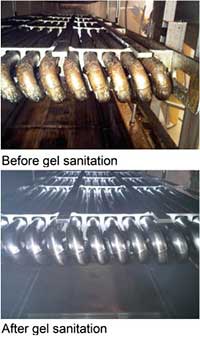Gel Sanitizing Chemicals Can Enhance Food Safety, Sustainability and the Bottom Line
By Brian March, Sani Marc
One of the biggest challenges for a food processor to switch from foam to gel sanitizing chemicals for production equipment including conveyors is the “that’s-the-way-we-have-always-done-it-for-years” attitude.
 Foam is the industry standard for cleaning and sanitation. It works, is highly visible so you can see where you have applied it, has an acceptable contact time, is cheap, and it can even be fun to apply. However, for the well informed processor, gel chemistry presents a compelling case for change.
Foam is the industry standard for cleaning and sanitation. It works, is highly visible so you can see where you have applied it, has an acceptable contact time, is cheap, and it can even be fun to apply. However, for the well informed processor, gel chemistry presents a compelling case for change.
Gel sanitizing chemicals are not new. The products have been around the industry for many years. What is new is a recent upsurge in interest. Food plants face increasing challenges to balance food safety with sustainability and cost competitiveness. Recent advances in the development and marketing of gel sanitizing chemicals are already helping some processors successfully meet those challenges, thus generating hubbub in the marketplace. So it appears that something old is new again.
The most persuasive reason is a dramatic reduction in the volume of chemicals used – a reported 40% to 75% decrease in annual usage. With this comes a significant reduction in chemical cost, as high as 50%, depending upon the price paid for the foam and the gel products. And the savings don’t stop there.
A quality gel program will require less water to apply the product and to later rinse it off. Studies are currently underway to quantify what savings could be expected, but anecdotal evidence indicates that these savings are substantial. Additionally, new uses for gel sanitizing chemicals, such as for equipment historically cleaned by circulation or immersion cleaning, both of which can use high volumes of water, are being discovered. Processors pay a lot of money for potable water and pay again to treat it before it is sent to the waste stream. Gel chemistry can contribute to a reduction in those costs which helps the bottom line, and the environment.
Food Safety, Water Conservation
Food safety is also improved by a quality gel chemical. Real world results at facilities that have switched to gel have repeatedly demonstrated both a reduction in ATP and microbiological sampling results. The reason is directly related to the improved viscosity of a gel versus a foam product. On horizontal surfaces, foam achieves the targeted contact time of 15 to 30 minutes as the foam collapses. However, on vertical surfaces, this is reduced to as little as 3-5 minutes as the weight of the foam pulls it to the floor. This is not the case with gel, which forms a thin film that can last up to 30 minutes without drying, even on vertical surfaces
With the improved viscosity, some are concerned about how well a gel product rinses. Generally speaking, this is not a big concern as most gel sanitizing chemicals rinse very well. In fact, one ingenious formulation has near-water viscosity in the concentrated form but becomes very viscous when it is diluted with water to a concentration of 3-5%, and then reverts to water-thin viscosity in the rinse stage. This synergistic reaction of the chemical ingredients to water is not common in all gels, but results in distinct advantages in cleaning efficiency and cost savings.
However, there are some caveats. The first, ironically, is the cost of gel. Some processors experience sticker shock as the price of a drum of gel is higher than what they pay for the same amount of foam. Too, if the gel manufacturer does not properly evaluate the processor’s facility and help it to optimize its cleaning operations, the cost savings of gel chemistry will not be realized. And not all gels are created equal. Some require warm water to apply, which can result in an increase in energy consumption. Others may require a high concentration to achieve the correct viscosity to maintain cleaning efficiency. However, a reputable chemical manufacturer will help a food processor to analyze in detail and demonstrate in-plant how the savings will be realized before the processor is asked to sign on the dotted line.
So think inside the box. Take a new look at something old: analyze how a quality gel cleaning program can enhance food safety and at the same time improve cleaning efficiency, environmental sustainability, and the bottom line.
About the Author
Brian March has worked in food plant sanitation in the ready-to-eat high risk sector for over 16 years. He is currently the Ontario Sales Manager for the Food & Beverage Division of Sani Marc Inc., a leading Canadian manufacturer of specialized cleaning and sanitizing solutions for food processing facilities. Sani Marc Inc. is the 2013 winner of the NSF-GFTC Allied Trades Food Safety Award for significant contribution to food safety through innovations in sanitation and a high standard of service to major companies.
To have more articles like this emailed to your inbox, become a GFSR Member today!

-
 FeaturedRisk management
The Cost of a Breach: What a Cyberattack Could Mean for Food Safety Recalls
FeaturedRisk management
The Cost of a Breach: What a Cyberattack Could Mean for Food Safety Recalls
-
 FeaturedRisk management
Securing the Food Chain: How ISO/IEC 27001 Strengthens Cybersecurity
FeaturedRisk management
Securing the Food Chain: How ISO/IEC 27001 Strengthens Cybersecurity
-
 FeaturedRisk management
Revolutionizing Food Safety Training: Breaking Out of the “Check-the-Box” Mentality
FeaturedRisk management
Revolutionizing Food Safety Training: Breaking Out of the “Check-the-Box” Mentality
-
 GFSI Standards
GFSI 2025: Building Trust, Tech-Forward Solutions, and Global Unity in Food Safety
GFSI Standards
GFSI 2025: Building Trust, Tech-Forward Solutions, and Global Unity in Food Safety
-
 FeaturedFood Safety
Integrated Pest Management: Strategies to Protect Your Brand’s Reputation
FeaturedFood Safety
Integrated Pest Management: Strategies to Protect Your Brand’s Reputation
-
 FeaturedFood Safety Culture & Training
No Open Door Policy: Challenges That Impact Pest Control in Food Processing Plants
FeaturedFood Safety Culture & Training
No Open Door Policy: Challenges That Impact Pest Control in Food Processing Plants



